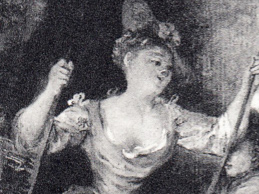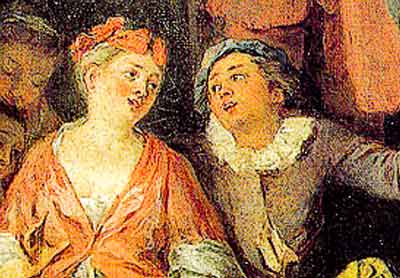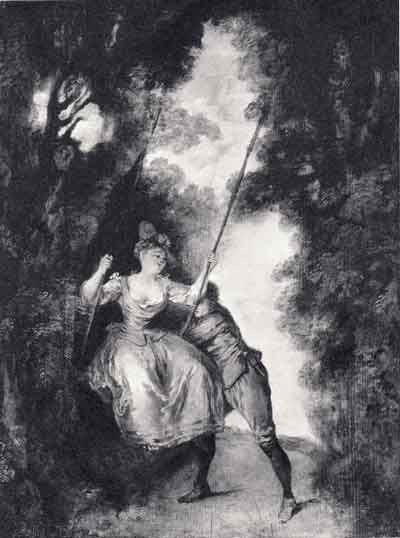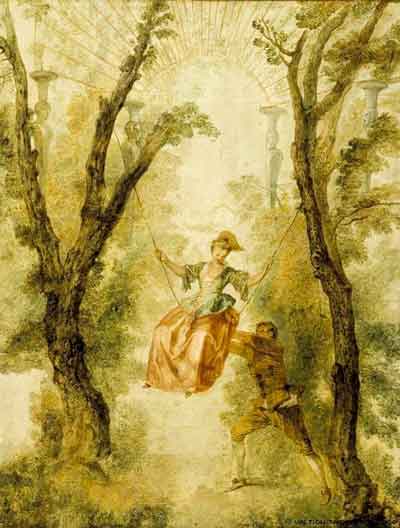
- Home Page
- Accepted
Paintings & Copies - Doubtful
Attributions - Doubtful Textual References
- Alternative
Titles - Collectors &
Museums - Bibliography
- Search Abecedario
- Watteau &
His Circle
X. L’Escarpolette
Entered February 2015
Whereabouts unknown
Oil on paper, mounted on panel
57 x 42 cm
ALTERNATIVE NAMES
La Balanceuse
La Balançoire
Jeune femme se balançant
PROVENANCE
(?)Paris, collection of M. Evans-Lombe. His sale, Paris, Hôtel Drouot, March 27-30, April 1, and May 2, 1863, lot 26: “WATTEAU (ANTOINE) . . .Jeune femme se balançant. Sur bois.” Although the auction data is minimal, the fact that the painting contained (or emphasized) just the woman and that it was on panel suggest that this may have been our painting.
Florence, collection of Paul (Pavel Pavlovich) Demidov, 2nd Prince of San Donato (1839-1885). His sale, Florence, San Donato Palace, March 15 ff, 1880, lot 1147: “WATTEAU (JEAN ANTOINE) . . . L’ESCARPOLETTE. Un jeune homme met en mouvement l’escarpolette sur laquelle est assise une jeune femme. Une des dernières oeuvres du maître, peinte l’année qui précéde sa mort. Morceau enlevé de verve, pétillant d’esprit et d’une charmante tonalité. Toile. Haut., 0 m. 54 cent.; larg., 0 m. 44 cent.” The picture sold for 10,000 fr. according to the published price list.
Paris, collection of Charles and Henri Porgès. Their sale, Paris, Hôtel Drouot, March 22, 1907, lot 12: “WATTEAU (ANTOINE) . . . Dans un parc, une jeune femme est assise sur une escarpolette, tenant de ses deux mains les cordes qui le soutiennent. Un jeune homme lui donne l’élan. Tête nue, les bras tendus, le torse pliant dans un gracieux effort, il est vêtu à la façon des Mezzetins, d’une veste ajustée et d’une culotte courte serrée sur des blancs. Des coques de ruban rouge ornent ses souliers. Son aimable compagne a les yeux baissés sur lui, les cheveux relevés, bouffant sous un petit chapeau de paille, la poitrine découverte et les bras demi-nus; elle porte un corsage de soie gris à larges manches et aux basques relevées sur une ample jupe de satin rose. A droite, un arbre au feuillage automnal. A gauche, un dieu Terme entouré d’une légère frondaison. Vers le fond, un cours d’eau. Au loin, une construction couverte de tuiles rouges, sous un ciel éclairé par le soleil couchant. Oeuvre rare, admirable de verve et d’esprit, d’une tonalité claire et lumineuse. Toile. Haut., 56 cent., larg., 46 cent. Ancienne collection de San Donato, no 1447.” The painting sold for $8,800 to M. Bieville according to a notice in American Art News, 5 (March 30, 1927), n.p. [5].
Paris, collection of André Chevrillon. Chevrillon’s ownership is cited by Réau but without documentation. This seems plausible since he owned other works from the Porgès collection such as a head painted by Greuze (sold London, Christie’s, May 14, 2009, lot 40). Perhaps Bieville acted as his agent at the Porgès sale. Adhémar mistranscribed the owner’s name as “Chevrillard,” and her error was repeated by Macchia and Montagni.
Paris, Galerie André Weil. This element in the provenance is cited by Adhémar but is otherwise undocumented
Paris, Galerie Wildenstein.
Paris, collection of Jules Strauss. His sale, Paris, Palais Galliera, March 7, 1961, lot 29: “WATTEAU (École de Jean-Antoine) . . . La balançoire. Une jeune femme en corsage rose et jupe jaune, coiffée d’un chapeau de paille légèrement incliné sur ses cheveux blonds, est assise sur une escarpolette que pousse un jeune homme debout à droite. Une perspective de parc s’ouvre entre des frondaisons automnales. Papier maroufflé sur bois. Haut., 0m 57; Larg., 0m42. Cadre en bois sculpté. Cf. Watteau par Mme Hélène ADHÉMAR (Paris, 1950) no 60 du catalogue avec les indications suivantes: «Non gravé. Donné par Strauss à Watteau: c’est une variante de «l’Escarpolette». Collection Wildenstein, collection Strauss». (Voir la reproduction, pl. XIII.)”
SELECT BIBLIOGRAPHY
Dacier, Vuaflart, and Hérold, Jean de Jullienne et les graveurs (1921-29), under cat. 40.
Réau, “Watteau” (1928), under cat. 264.
Adhémar, Watteau (1950), under cat. 59, cat. 60.
Macchia and Montagni, L’opera completa di Watteau (1968), under cat. 36.
Eideberg, “The Young Lancret and Watteau” (2015).
REMARKS
This painting and a Watteau arabesque known as L’Escarpolette are closely linked. The total extent of Watteau’s original arabesque was engraved by Louis Crépy fils, but just the central portion of Watteau’s design is preserved and is in the Helsinki museum. As it happens, the painting under consideration here likewise corresponds to just the figurative elements and trees in the central portion of Watteau’s arabesque, but omits all the decorative enframement. Even then there are differences. The man is less energetic in the way he pushes the swing, and he is closer to his companion—so much so that his face and the right side of his body are obscured by her’s. The angle of the woman’s body has been turned to the right and, rather than looking down, her head is lifted slightly upward. In short, this is a very free variant of Watteau’s composition.

Nicolas Lancret, L’Escarpolette (detail).

Nicolas Lancret, Concert dans un parc (detail), oil on canvas. Whereabouts unknown.
Because of the overall similarity to Watteau’s composition, this painting has in the past been given to Watteau, especially in the nineteenth century when scholars were overly generous in their attributions. In the twentieth century, the picture remained somewhat in the shadows. Dacier, Vuaflart, and Hérold referred to it in relation to Watteau’s arabesque, but without weighing in on whether they thought it was autograph. Réau described it as a “replica” of Watteau’s arabesque. Surprisingly, Adhémar retained it as an autograph work. Yet one need consider just the woman’s face to measure the gulf that separates this painting from Watteau’s established works. Her head is too large, her short nose has flared nostrils, her parted lips and gently ecstatic mood is quite unlike Watteau’s evasive expressions. Instead, the stylistic parallels are with Lancret’s early works and it is to that master that this painting should be assigned.
That Lancret followed a Watteau invention is not surprising since, after all, his Conversation galante in the Wallace Collection, the painting he may have submitted to the Académie royale in 1718, contains a paraphrase of Watteau’s Voulez-vous triompher des belles?
The history and provenance of this painting has become jumbled in recent Watteau literature, especially because Adhémar confused this work and the Helsinki fragment of the original Watteau, distributing its provenance under two separate entries. Macchia and Montagni repeated Adhémar’s mistake.

